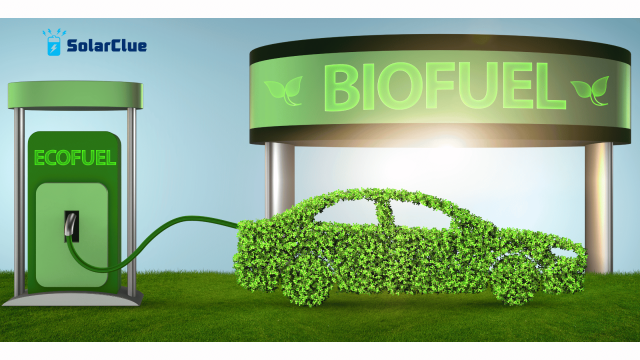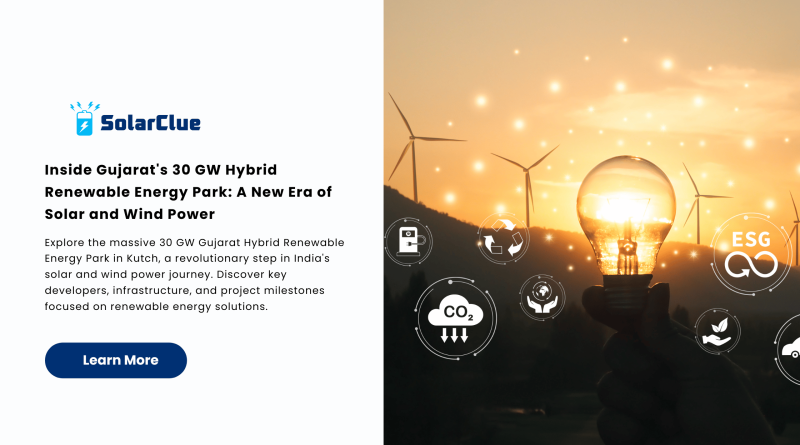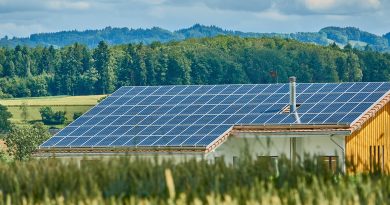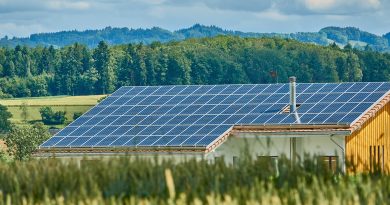Inside Gujarat’s 30 GW Hybrid Renewable Energy Park: A New Era of Solar and Wind Power
India’s journey toward a sustainable energy future has taken a monumental leap with the launch of the 30 GW Gujarat Hybrid Renewable Energy Park in the Kutch district. Positioned near the Vighakot BSF post along the international border, this ambitious project aims to redefine the country’s renewable energy landscape by combining solar power and wind energy on a massive scale. As a result, the nation moves closer to its green goals.
Table of Contents
Project Overview
Under Gujarat’s government waste land policy, the state allocated approximately 72,400 hectares to develop up to 27,700 MW of renewable energy capacity. In addition, planners have earmarked the remaining capacity to reach 30 GW for future expansion. Clearly, this scale of deployment makes it one of the largest hybrid renewable energy initiatives in the world.
Key Developers and Allocations
Authorities have assigned land to six key developers. They must complete 50% of their capacity within three years and the full capacity within five years of the new approach road’s completion, dated 31st December 2021. Consequently, developers are working on tight timelines to meet targets.
| Developer | Capacity (MW) | Land Allotted (Ha) |
|---|---|---|
| Adani Green Energy Ltd (AGEL) | 9500 | 19000 |
| NTPC | 4750 | 9500 |
| Gujarat State Electricity Corp Ltd (GSECL) | 3325 | 6650 |
| Gujarat Industrial Power Company Ltd (GIPCL) | 2375 | 4750 |
| Sarjan Realities Ltd (SRL) | 4750 | 9500 |
| Solar Energy Corporation of India (SECI) | 3000 (wind only) | 23000 |
| Total | 27700 | 72400 |
Infrastructure Development
Planners are building significant infrastructure to support this massive solar power and wind energy park. Furthermore, several key areas of construction are already underway:
1. Road Connectivity:
Construction of a new 16.26 km approach road and 40.83 km of road widening and strengthening is underway. It should finish by the end of 2021.
2. Transmission System:
The Central Electricity Authority (CEA) and the Central Transmission Utility (CTU, under PGCIL) are handling the evacuation and transmission systems. Moreover, developers must submit connectivity applications and obtain long-term access.
3. Pooling Substations:
The Gujarat government allocated 300 hectares for three pooling substations, each designed for ~10 GW capacity.
4. Right of Way:
Authorities have designated a 1500-meter-wide transmission corridor to ensure efficient grid connectivity.
5. Water Solutions:
Developers will install brackish groundwater desalination plants to meet operational water needs.
6. Construction Power:
PGVCL will provide construction power once developers apply and pay applicable charges.
Environmental and Economic Impact

This large-scale renewable energy park will significantly lower India’s carbon emissions and support both national and global climate goals. By expanding the use of solar panels, the project contributes to a cleaner grid. Moreover, it encourages the replacement of traditional fossil fuels with high-efficiency solar power systems.
The park’s economic impact is equally impressive. Thousands of jobs will emerge in infrastructure development, panel installation, maintenance, and manufacturing. As a result, local communities in the Kutch region will benefit through enhanced employment opportunities, better roads, and improved utilities. These advantages demonstrate how industrial progress can align with environmental responsibility.
In terms of cost, mass implementation of solar and wind systems drives down installation prices. Because of these economies of scale, the cost per watt for solar panel deployment has steadily decreased, making clean energy more affordable for large-scale users.
Additionally, incorporating high solar panel efficiency technology ensures maximum power generation with minimal space usage—critical for utility-scale projects like this one. Consequently, energy yield and long-term returns on investment increase.
Strategic Significance
This hybrid park offers several long-term benefits. Most importantly:
1. It strengthens India’s global clean energy leadership.
2. It reduces dependence on imported fuels, aligning with “Atmanirbhar Bharat.”
3. It fosters rural development through sustainable infrastructure and community inclusion.
4. It rapidly expands national capacity for solar power and wind energy.
Conclusion
The Gujarat Hybrid Renewable Energy Park stands as a bold step toward India’s clean energy goals. With top-tier developers, strong government support, and cutting-edge infrastructure, the project marks a milestone in the nation’s transition to renewable energy. Furthermore, it accelerates the use of advanced solar power systems, efficient solar panels, and broader integration of wind power. Therefore, this park is more than an energy project—it’s a movement toward a greener future.
Looking to stay updated with India’s renewable energy journey? Explore insights and stories at solarclue.com and blog.solarclue.com!
FAQs
1. What makes Gujarat’s Hybrid Renewable Energy Park unique?
It combines both solar power and wind energy on a massive scale, offering 30 GW of clean energy potential across 72,400 hectares—making it one of the largest hybrid parks in the world.
2. Which companies are involved in this solar and wind initiative?
Major developers such as Adani Green, NTPC, GSECL, GIPCL, SRL, and SECI are actively contributing thousands of megawatts in solar and wind capacity.
3. What is the role of solar panels in this project?
Solar panels serve as the core technology for energy generation, efficiently converting sunlight into electricity through advanced materials and configurations that enhance solar panel efficiency.
4. How will the energy be transmitted from the park?
CEA and CTU are executing a detailed transmission and evacuation plan. This includes pooling substations and corridor space for power lines, ensuring smooth integration with the national grid.
5. How does this project support solar energy goals in India?
It boosts India’s efforts to become a world leader in renewable energy, cuts emissions, creates local employment, and facilitates access to scalable solar power systems for long-term sustainability.
Looking to stay updated with India’s renewable energy progress? Visit solarclue.com and explore in-depth articles at blog.solarclue.com!



